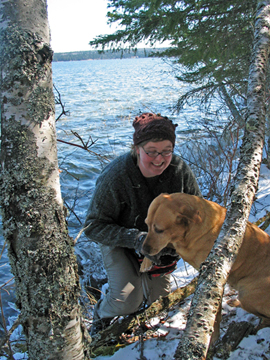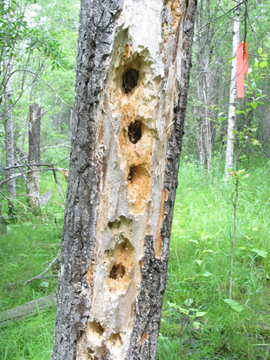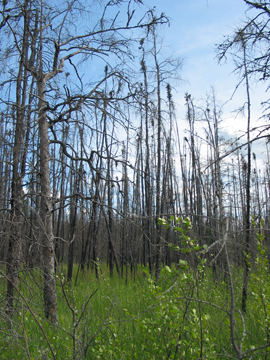Heather Clarke
 |
Heather ClarkeDetermining the effects of partial harvesting in riparian buffers on cavity-nesting birds in the boreal forest.email: hclarke@ualberta.ca |
|
MSc Research
Weyerhaeuser is attempting to alleviate some of this harvesting pressure by developing alternative logging practices, intended to emulate natural disturbances. In riparian areas, the practice is applied through the development of a 40 meter wide, partially harvested (5-25% tree retention) buffer along lake edges. This practice has been developed very recently, and has not yet been evaluated in terms of ecosystem effects. This is where my research comes in….
In addition, I am examining nesting and foraging habitat selection by cavity nesters at tree, stand, and larger landscape scales. This will determine which features, if any, are of particular interest for forest companies in future harvest planning, and conservationists for the development of protected areas. |
|
|
Last Modified:2006-10-03 |
 My
study site is located in central Saskatchewan, in the boreal-plains ecoregion.
This area represents the transition zone from the less vegetated, more
arable land in the south, to the boreal forest in the north. It provides
habitat for a diverse array of wildlife due to its structural and compositional
diversity, and is of increasing conservation concern as harvesting practices
increase throughout the region.
My
study site is located in central Saskatchewan, in the boreal-plains ecoregion.
This area represents the transition zone from the less vegetated, more
arable land in the south, to the boreal forest in the north. It provides
habitat for a diverse array of wildlife due to its structural and compositional
diversity, and is of increasing conservation concern as harvesting practices
increase throughout the region. I
am examining the community structure and of cavity-nesting birds in naturally
burned, partially harvested, and intact riparian forests. This will determine
both the effectiveness of a partial harvest approach in terms of natural
disturbance emulation, as well as any overall harvesting effects on the
bird communities.
I
am examining the community structure and of cavity-nesting birds in naturally
burned, partially harvested, and intact riparian forests. This will determine
both the effectiveness of a partial harvest approach in terms of natural
disturbance emulation, as well as any overall harvesting effects on the
bird communities.